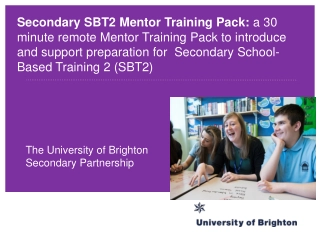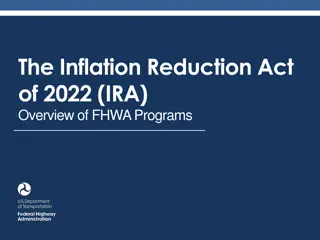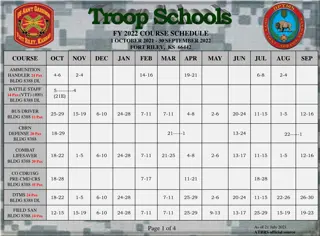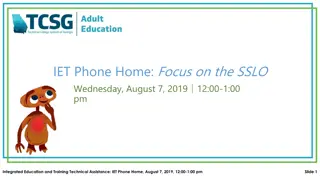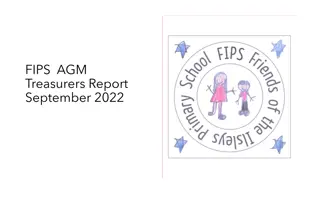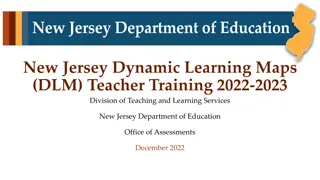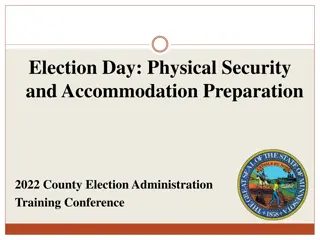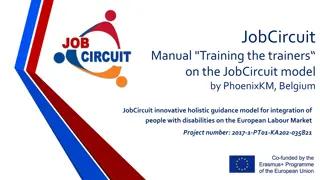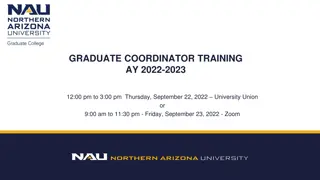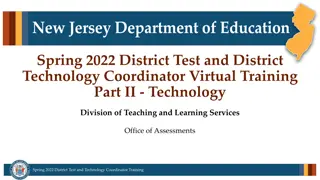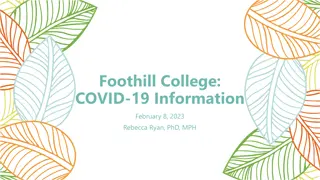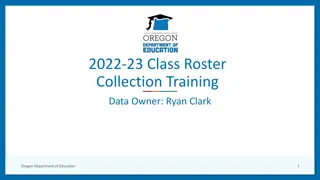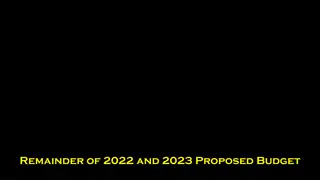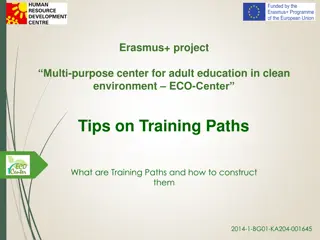PCIA Training September 2022 Overview
The PCIA Training set for September 2022 includes an evaluation process overview, new PCIA rubric, accessing the new portal, and details about the drafting of the PCIA rubric. This training covers important aspects related to the evaluation process and roles of paraprofessionals.
Download Presentation

Please find below an Image/Link to download the presentation.
The content on the website is provided AS IS for your information and personal use only. It may not be sold, licensed, or shared on other websites without obtaining consent from the author.If you encounter any issues during the download, it is possible that the publisher has removed the file from their server.
You are allowed to download the files provided on this website for personal or commercial use, subject to the condition that they are used lawfully. All files are the property of their respective owners.
The content on the website is provided AS IS for your information and personal use only. It may not be sold, licensed, or shared on other websites without obtaining consent from the author.
E N D
Presentation Transcript
PCIA Training September 2022 Heather Grant, CMSD Jillian Ahrens, CTU
AGENDA Evaluation Process Overview New PCIA Rubric Accessing the New Portal
Evaluation Process Overview Paraprofessionals: Are evaluated in TDES Have a two document submission and composite events Are not required to write Growth Plans Do not write lesson plans or for evaluation purposes Do not have observational events Are evaluated by the principal, AP, or CIS
Evaluation Process Overview Paraprofessionals: Who earn an Accomplished rating get 2 years off Who earn a Skilled rating get 1 year off
Evaluation Process Overview 1. 2. 3. 4. 5. 6. Evaluator schedules conference date. Para reviews and confirms conference date. Evaluator confirms conference date. Para submits evidence for Domain 1/4 in portal. Para completes self evaluation on rubric. Evaluator reviews evidence and marks areas of agreement/disagreement on the rubric. Para reviews rubric and additional evidence from evaluator. Para and evaluator meet for conference and finish rubric. A composite is completed at the end of the year. 7. 8. 9.
New PCIA Rubric In the Fall of 2021, a joint CMSD/CTU Committee met to review the Paraprofessional rubric and write a separate rubric for the PCIA role. The following representatives served on the committee along with the members of the TDES Steering Committee: CMSD CTU Bill Stencil Cherylane Jones-Williams Trish Tillow Lakisha Tuggle Shaunamichelle Leonard Ida Wells Amy Mobley Tyler Hughley
Drafting the PCIA Rubric We used the Paraprofessional Rubric for alignment Every component has the paraprofessional role changed to PCIA References to classroom education language were removed Most components were changed slightly and others were designed specifically for the role of a PCIA (Planning Center and SEL)
Drafting the PCIA Rubric Paraprofessional Rubric Domains PCIA Rubric Domains 1: Planning & Preparation 1: Planning & Preparation 2: The Classroom Environment 2: Planning Center Environment 3: Instruction 3: SEL 4: Paraprofessional Responsibilities 4: Paraprofessional Responsibilities
Drafting the PCIA Rubric Component Ineffective Developing Skilled Accomplished 1a: Demonstratin g knowledge of content and strategie s ParaprofPCIA displays little knowledge of required content and strategies ParaprofessionalPCIA displays some knowledge of required content and strategies Paraprofessional PCIA displays solid knowledge of required content and strategies Paraprofessional PCIA displays extensive knowledge of required content and strategies 1b: Paraprofessional PCIA demonstrates little or no knowledge of students backgrounds, cultures, skills, language proficiency, Paraprofessional PCIA understands the importance of understanding students backgrounds, cultures, skills, language proficiency, Paraprofessional PCIA actively seeks knowledge of students backgrounds, cultures, skills, language proficiency, interests, and special needs, and attains this knowledge for groups of students. Paraprofessional PCIA actively seeks knowledge of students backgrounds, cultures, skills, language proficiency, interests, and special needs from a variety of sources, and attains this knowledge for individual students. Demonstratin g knowledge of students interests, and special needs, and attains this knowledge for the class as a whole. (knowledge of students on a personal level) interests, and special needs, and does not seek such understanding.
Drafting the PCIA Rubric Component Ineffective Developing Skilled Accomplished 1d: PCIA demonstrates little or no familiarity with resources used in instruction to enhance their own knowledge, to use in teaching, or for students who need them. PCIA does not seek such knowledge. PCIA demonstrates some familiarity with resources used in instruction that are available through the school or district to enhance their own knowledge, to use in teaching, or for students who need them. PCIA makes some attempt does not seek to extend such knowledge. PCIA is fully aware of the resources used in instruction that are available through the school or district to enhance own knowl edge, to use in teaching, or for students who need them. PCIA seeks out additional resources for instruction in and beyond the school or district in professional Demonstra ting knowledge of resourc es* organizations, on the Internet, and in the community to enhance own knowledge, to use in teaching, and for students who need them.
Drafting the PCIA Rubric Component Ineffective Developing Skilled Accomplished 2a: Assists in creating Creates an environme nt of respect and rapport Classroom Interactions, both between the PCIA teacher, paraprofessional and students and among students, are negative, inappropriate, or insensitive to students cultural backgrounds, and characterized by sarcasm, put-downs, or conflict. Classroom Interactions, both between the PCIA teacher, paraprofessional and students and among students, are generally appropriate and free from conflict but may be characterized by occasional displays of insensitivity or lack of responsiveness to cult ural or developmental differences. among stu dents. Classroom Interactions, b etween teacher PCIA and students and among students are polite and respectful, reflecting general warmth and caring, and are appropriate to the cultural and developmental differences. among groups of students. Classroom Interactions among the PCIA teacher and individual students are highly respectful, reflecting genuine warmth and caring and sensitivity to students cultures and levels of development. Students themselves ensure high levels of civility among members of the class.
Drafting the PCIA Rubric Component Ineffective Developing Skilled Accomplished 2b: Assists in establishi ng Establishes a culture for learning and support th at is challenging and rigorou s Paraprofessional PCIA demonstrates very little commitment to the learning culture and, holds low expectations for student support achievemen t. ParaprofessionalPCIA s demonstrate some commitment to the learning culture and modest expectations for student support achievement. ParaprofessionalPCIA s demonstrate strong commitment to the learning culture and high expectations for student support achievement for most students. ParaprofessionalPCIA s demonstrates passionate commitment to the learning culture and high expectations for student support achievement for all students.
Drafting the PCIA Rubric Component Ineffective Developing Skilled Accomplished 2c: Assists in managing Manages classroom Planning Center procedures Paraprofessional assistance with classroom Planning Center procedures is are ineffective. Paraprofessional assistance with classroom Planning Center procedures is are partially effective. Paraprofessional assistance with classroom Planning Center procedures is are effective. Paraprofessional assistance with classroom Planning Center procedures is are highly effective and seamless and may includes students in the performance and maintenance of Planning Center classroom routines.
Drafting the PCIA Rubric Component Ineffective Developing Skilled Accomplished 2d: Assists managing Manages student behavior Paraprofessional PCIA response to student misbehavior is repressive, disrespectful, or nonexistent. Paraprofessionals PC IA does not know or implement de- escalation strategies and/or classroom standards of conduct. Paraprofessional PCIA response to student misbehavior is inconsistent. Paraprofessional PCIA attempts to implement de- escalation strategies and/or classroom standards of conduct. Paraprofessional PCIA response to student misbehavior is appropriate and respects the students dignity. Paraprofessional PCIA Paraprofessional PCIA response to student behavior is sensitive to individual students and preventive. Paraprofessional PCIA clearly understands de- escalation strategies and/or standards of classroom standards of conduct and may assists students in setting and monitoring classroom standards. understands and enforces implements de-escalation strategies and/or classroom standards of conduct.
Drafting the PCIA Rubric Component Ineffective Developing Skilled Accomplished 2e: Assists in organizi ng Organizes physical space ParaprofessionalP CIA makes no attempt to collaborate to modify physical space to maintain safety, organization and access to learning. Paraprofessional PCIA makes a partial attempt to collaborate to modify physical space to maintain safety, organization and access to learning. Paraprofessional PCIA collaborates to ensures that the physical space is safe, organized and appropriate for contributes to the learning activities, including use of technology. Paraprofessional PCIA makes a significant contribution to the classroom to ensures that the physical space is safe, organized and contributes to appropriate for the learning activities, in cluding effective use of technology.
Drafting the PCIA Rubric Component Ineffective Developing Skilled Accomplished 3a: Communicat ing with students Expectations for learning, directions and procedures, and explanations of SEL content are unclear or confusing to students. Expectations for learning, directions and procedures, and explanations of SEL content are clarified after initial confusion. Expectations for learning, directions and procedures, and explanations of SEL content are clear to students. Expectations for learning, directions and procedures, and explanations of SEL content are clear to students. Paraprofessional s PCIA communication is appropriate to students cultures and levels of development. Paraprofessional s PCIA use of language is correct but may not be completely appropriate to students cultures or levels of development. Paraprofessional s PCIA communication is clear and expressive, appropriate to students cultures and levels of development, and anticipates possible student misconceptions. Paraprofessional s PCI A use of language contains errors or is inappropriate to students cultures or levels of development.
Drafting the PCIA Rubric Component Ineffective Developing Skilled Accomplished 3b: Using questioning and discussi on techniq ues Paraprofessional s PCI A ask few or no questions. Questions are low-level or inappropriate, eliciting limited or no student response. Some of the Paraprofessional s PCIA questions elicit a thoughtful response, but most are low- level posed in rapid succession. Most of the Paraprofessional s PCIA questions elicit a thoughtful response, and the Paraprofessional PCIA allows sufficient wait time for students to answer. Paraprofessional s PCIA questions reflect high expectations and are culturally and developmentally appropriate. Questions are adjusted based on student response to guide learning.
Drafting the PCIA Rubric Component Ineffective Developing Skilled Accomplished 3c: Understands Engaging students in learning PCIA demonstrates no knowledge of appropriate activities or and assignments, strategies, materials and groupings of students are inappropriate to the instructional expected outcomes, or students cultures or levels of understanding, resulting in little minimal reflection. intellectual engagement. The lesson has no structure or is poorly paced. PCIA demonstrates some knowledge of activities and assignments,strategies, materials, and groupings of students are partially appropriate to the expectedinstructional outcomes, or students cultures or levels of understanding, resulting in moderate intellectual engagement. The lesson has a recognizable structure but is not fully maintained. PCIA demonstrates full knowledge of activities and assignments strategies, materials, and groupings of students are fully appropriate to the instructional expected outcomes, and students cultures and levels of understanding. Assists teacher in Engages all students in work of at a high level. of rigor engagement. The lesson s structure is coherent, with appropriate pace. Students are highly intellectually engaged throughout the lesson in significant learning, and make material contributions to the activities, student groupings, and materials. The SEL learningis adapted as needed to the needs of individuals, and the structure and pacing allow for student reflection and closure. reflection OR SEL learning
Drafting the PCIA Rubric Component Ineffective Developing Skilled Accomplished 3d: Understands the Use of Assessment in Instruction PCIA does not demonstrate an understanding of assessing the SEL needs of students. assessment used in instruction. Feedback to students is absent or incorrect. PCIA demonstrates a limited understandingof assessing the SEL needs of students. Feedback to students is inconsistent in frequency or quality. PCIA demonstrates a solid understandingof assessing the SEL needs of students. assessment used in instruction. Feedback to students is clear consistent and accurate. PCIA demonstrates a deep understanding of assessing the SEL needs of students. assessment used in instruction. Feedback to students is high quality and appropriate to the individual student. Assessing the SEL needs of the students 3e: Demonstrating flexibility and responsivenes s PCIA demonstrates little or no flexibility in response to student SEL instructional needs. PCIA makes some attemptto meet student SEL instructional needs. PCIA effectively meets student instructional SEL needs. PCIA anticipates student SEL instructional needs and responds appropriately and effectively.
New PCIA Rubric Components with role specific changes: 1a: Demonstrating knowledge of content, social and emotional learning (SEL), and/or strategies 1b: Demonstrating knowledge of students 1d: Demonstrating knowledge of resources* 2d: Manages student behavior 3c: Engaging students in reflection and/or SEL 3d: Assessing the SEL needs of the students 3e: Demonstrating flexibility and responsiveness
New PCIA Rubric Domain 1: Planning & Preparation COMPONENT SKILLED 1a: Demonstrating knowledge of content, social and emotional learning (SEL), and/or strategies PCIA displays solid knowledge of required content, SEL competencies, and/or strategies. 1b: Demonstrating knowledge of students PCIA actively seeks knowledge of students backgrounds, cultures, skills, language proficiency, interests, and special needs. 1d: Demonstrating knowledge of resources* PCIA is fully aware of the resources that are available through the school or district to enhance own knowledge or for students who need them.
New PCIA Rubric Domain 2: Planning Center Environment COMPONENT SKILLED 2d: Manages student behavior PCIA response to student misbehavior is appropriate and respects the students dignity. PCIA understands and implements de-escalation strategies and/or building standards of conduct.
New PCIA Rubric Domain 3: SEL COMPONENT SKILLED 3c: Engaging students in reflection and/or SEL PCIA s use of activities, strategies, and materials are fully appropriate to the expected outcomes and students cultures and levels of understanding. Engages students in a high level of reflection and SEL. PCIA demonstrates a solid understanding of assessing the SEL needs of students. Feedback to students is clear, consistent, and accurate. 3d: Assessing the SEL needs of the students 3e: Demonstrating flexibility and responsiveness PCIA effectively meets student SEL needs.


